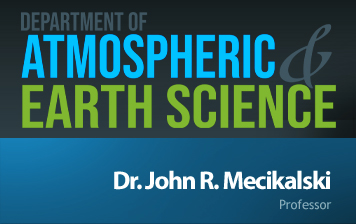Satellite-based Convective Storm & Convective Initiation Studies
Convective Diagnostic Research
 Background:
Background:
The proposed research will involve coupling current GOES and MSG satellite spectral information used to determine cumulus cloud and growth with data that mimics that to be collected by the Geostationary Lightning Mapper (GLM) [from TRMM’s Lightning Imaging Sensor (LIS)] towards identifying the correlation between strong updrafts, lightning intensity, and thunderstorm severity. Here, “storm severity” is defined as those aspects of a thunderstorm defined as severe (e.g., strong surface winds >25 ms-1). This project will produce a satellite-based “storm intensity index” product designed to substantially enhance our ability to isolate updrafts within thunderstorms, and the related hazards that accompany the occurrence of strong updrafts within active portions of convective storms, specifically heavy rainfall, frequent cloud-to-ground lightning, overshooting tops (and hence locations that generate severe turbulence aloft for aircraft), and subsequent ground-level heavy rainfall, and microbursts (caused by the collapse of updraft cores). The work will benefit two societal sectors, public and aviation safety. The main aviation safety linkage will come through demonstration of rapid feature expansion, overshooting top identification and spatial location mapping, and henceforth, assessing regions of likely cloud-induced turbulence associated with gravity wave generation aloft.
Main Results
Using MSG SEVIRI IR data over tropical Africa for 2-3 months, information gained from recent research (Mecikalski et al. 2010a,b; Siewert et al. 2010), along with total lightning data from TRMM LIS via the “Global Total Lightning Flash” product, correlations in space and time will be developed between CI/LI “interest fields, ” strong cumulus cloud growth and intense lightning. Cumulus clouds will be identified using the algorithm of Berendes et al. (2008) and the GOES-R cloud-typing algorithm. Given the degree of correlation between IR fields (e.g., 10.8 µm TB cloud-top cooling rates; 6.2–7.3 µm, 6.2–10.8 µm to identify updraft depth; 8.5–10.8 µm and 3.9 µm reflectance for cloud-top glaciation), lightning frequency and cumulus clouds, we expect to be able to pin-point new and strong/severe storms on spatial scales of 3 km (the MSG footprint near the Equator). NWP data will assist by providing CAPE and CIN (to determine environments capable of supporting storm storms) and precipitable water (to estimate rainfall rates and microburst potential). The severity index product will be demonstrated as a GOES-R capability, one that takes advantage of the expected high temporal, spatial and spectral resolution the ABI and GLM will provide.

